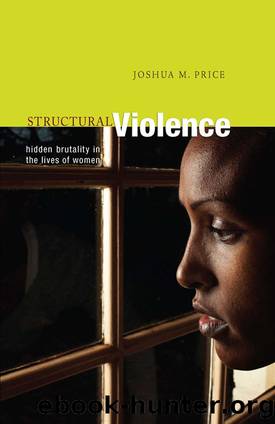Structural Violence by Joshua M. Price

Author:Joshua M. Price [Price, Joshua M.]
Language: eng
Format: epub
Tags: Social Science, Women's Studies, Violence in Society
ISBN: 9781438443454
Google: zE61xormwD0C
Publisher: SUNY Press
Published: 2012-09-18T04:00:33+00:00
WITNESS TO COUNTERPUBLICSâWITH A CAVEAT
The voices of women in sex work give an abundance of detail that belies attempts to simplify. The framing of the voices in a way that reveals the differences among them is an antidote to the tendency to see all violence against women as the same and as domestic. It also contradicts the tendency to see sex work as a monolith. I advocate an emphasis on differences rather than diversity because of the way Homi Bhaba, in a different context, distinguishes between cultural difference and cultural diversity. Though the differences we take up here do not seem to be particularly cultural, I do find his way of drawing distinctions quite helpful as we build a politics. As Homi Bhabha glosses it: âCultural diversity is the recognition of pre-given cultural contents and customs; held in a time frame of relativism it gives rise to liberal notions of multiculturalism, cultural exchange or the culture of humanityâ (Bhabha 1994, 34â35).
Difference implies instead a ânegation of the certitude in the articulation of new cultural demands, meanings, strategies in the political presentâ (Bhabha 1994, 34â35). Incorporating voices of women who have faced violence counteracts the tendency to reduce prostitutes or lesbians each to a pregiven common type and focuses instead on the multiple voicings of location and direction and the modalities of self-identification. The voices I have included give ample testimony to the multiplicity of positions, politics, and spatial trajectories, places of fear, and places of safety.
Can one call a âcounterpublicâ the discursive arena in which women working as prostitutes voice their accounts of violence? I think one can, as long as one acknowledges the contradictory logics that overdetermine prostitutes' public speech as false; as long as one takes stock of the fact that many listeners are likely to begin by assuming that prostitutes cannot be raped, that violence comes with the territory, or that it is deserved. With that discursive context in mind, one can see and appreciate the innovative strategies that activists employ in order to register their voices. Bruce Robbins has even gone so far as to propose that âthe public sphereâ could replace âcultureâ as an important category for social analysis: âIt serves as a critique of monolithic notions of power ⦠Unlike âhegemony,â the public sphere is less on the side of rule, more open to opposing views. Unlike âcultureâ it is more obviously a site of intersections with other classes and cultures ⦠[I]t is to stress a site of interaction and continuing self-formation rather than a given or self-sufficient body of ideas and practices distinguishing one from othersâ (Robbins 1993, xvii).
The benefit of the âcounterpublicâ is that it designates a discursive scene in which women who work in prostitution can try to make sense of their situations, communicate their interpretations of their situations, and forge solutions to the multiple forms of violence they face.
How do we account for voices that operate outside of counterpublics and the significance of those alternative contexts in the formation
Download
This site does not store any files on its server. We only index and link to content provided by other sites. Please contact the content providers to delete copyright contents if any and email us, we'll remove relevant links or contents immediately.
The Secret History by Donna Tartt(18843)
The Social Justice Warrior Handbook by Lisa De Pasquale(12141)
Thirteen Reasons Why by Jay Asher(8792)
This Is How You Lose Her by Junot Diaz(6794)
Weapons of Math Destruction by Cathy O'Neil(6142)
Zero to One by Peter Thiel(5685)
Beartown by Fredrik Backman(5595)
The Myth of the Strong Leader by Archie Brown(5424)
The Fire Next Time by James Baldwin(5248)
How Democracies Die by Steven Levitsky & Daniel Ziblatt(5127)
Promise Me, Dad by Joe Biden(5087)
Stone's Rules by Roger Stone(5026)
A Higher Loyalty: Truth, Lies, and Leadership by James Comey(4843)
100 Deadly Skills by Clint Emerson(4840)
Rise and Kill First by Ronen Bergman(4701)
Secrecy World by Jake Bernstein(4644)
The David Icke Guide to the Global Conspiracy (and how to end it) by David Icke(4624)
The Farm by Tom Rob Smith(4434)
The Doomsday Machine by Daniel Ellsberg(4415)
